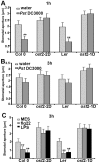RIN4 functions with plasma membrane H+-ATPases to regulate stomatal apertures during pathogen attack
- PMID: 19564897
- PMCID: PMC2694982
- DOI: 10.1371/journal.pbio.1000139
RIN4 functions with plasma membrane H+-ATPases to regulate stomatal apertures during pathogen attack
Abstract
Pathogen perception by the plant innate immune system is of central importance to plant survival and productivity. The Arabidopsis protein RIN4 is a negative regulator of plant immunity. In order to identify additional proteins involved in RIN4-mediated immune signal transduction, we purified components of the RIN4 protein complex. We identified six novel proteins that had not previously been implicated in RIN4 signaling, including the plasma membrane (PM) H(+)-ATPases AHA1 and/or AHA2. RIN4 interacts with AHA1 and AHA2 both in vitro and in vivo. RIN4 overexpression and knockout lines exhibit differential PM H(+)-ATPase activity. PM H(+)-ATPase activation induces stomatal opening, enabling bacteria to gain entry into the plant leaf; inactivation induces stomatal closure thus restricting bacterial invasion. The rin4 knockout line exhibited reduced PM H(+)-ATPase activity and, importantly, its stomata could not be re-opened by virulent Pseudomonas syringae. We also demonstrate that RIN4 is expressed in guard cells, highlighting the importance of this cell type in innate immunity. These results indicate that the Arabidopsis protein RIN4 functions with the PM H(+)-ATPase to regulate stomatal apertures, inhibiting the entry of bacterial pathogens into the plant leaf during infection.
Conflict of interest statement
The authors have declared that no competing interests exist.
Figures









Similar articles
-
Phosphorylation of the Plant Immune Regulator RPM1-INTERACTING PROTEIN4 Enhances Plant Plasma Membrane H⁺-ATPase Activity and Inhibits Flagellin-Triggered Immune Responses in Arabidopsis.Plant Cell. 2015 Jul;27(7):2042-56. doi: 10.1105/tpc.114.132308. Epub 2015 Jul 21. Plant Cell. 2015. PMID: 26198070 Free PMC article.
-
Investigating the functions of the RIN4 protein complex during plant innate immune responses.Plant Signal Behav. 2009 Dec;4(12):1107-10. doi: 10.4161/psb.4.12.9944. Plant Signal Behav. 2009. PMID: 20514222 Free PMC article. Review.
-
An Arabidopsis Plasma Membrane Proton ATPase Modulates JA Signaling and Is Exploited by the Pseudomonas syringae Effector Protein AvrB for Stomatal Invasion.Plant Cell. 2015 Jul;27(7):2032-41. doi: 10.1105/tpc.15.00466. Epub 2015 Jul 21. Plant Cell. 2015. PMID: 26198069 Free PMC article.
-
GENERAL CONTROL NONREPRESSIBLE4 Degrades 14-3-3 and the RIN4 Complex to Regulate Stomatal Aperture with Implications on Nonhost Disease Resistance and Drought Tolerance.Plant Cell. 2017 Sep;29(9):2233-2248. doi: 10.1105/tpc.17.00070. Epub 2017 Aug 30. Plant Cell. 2017. PMID: 28855332 Free PMC article.
-
The role of the plasma membrane H+-ATPase in plant-microbe interactions.Mol Plant. 2011 May;4(3):416-27. doi: 10.1093/mp/ssq083. Epub 2011 Feb 7. Mol Plant. 2011. PMID: 21300757 Free PMC article. Review.
Cited by
-
Two serine residues in Pseudomonas syringae effector HopZ1a are required for acetyltransferase activity and association with the host co-factor.New Phytol. 2015 Dec;208(4):1157-68. doi: 10.1111/nph.13528. Epub 2015 Jun 23. New Phytol. 2015. PMID: 26103463 Free PMC article.
-
Overlapping Local and Systemic Defense Induced by an Oomycete Fatty Acid MAMP and Brown Seaweed Extract in Tomato.Mol Plant Microbe Interact. 2023 Jun;36(6):359-371. doi: 10.1094/MPMI-09-22-0192-R. Epub 2023 Jul 28. Mol Plant Microbe Interact. 2023. PMID: 36802868 Free PMC article.
-
Plant stomata: a checkpoint of host immunity and pathogen virulence.Curr Opin Biotechnol. 2010 Oct;21(5):599-603. doi: 10.1016/j.copbio.2010.05.006. Epub 2010 Jun 21. Curr Opin Biotechnol. 2010. PMID: 20573499 Free PMC article. Review.
-
A prominent role of the flagellin receptor FLAGELLIN-SENSING2 in mediating stomatal response to Pseudomonas syringae pv tomato DC3000 in Arabidopsis.Plant Physiol. 2010 Jul;153(3):1188-98. doi: 10.1104/pp.110.157016. Epub 2010 May 10. Plant Physiol. 2010. PMID: 20457804 Free PMC article.
-
PRRs and NB-LRRs: From Signal Perception to Activation of Plant Innate Immunity.Int J Mol Sci. 2019 Apr 16;20(8):1882. doi: 10.3390/ijms20081882. Int J Mol Sci. 2019. PMID: 30995767 Free PMC article. Review.
References
-
- Chisholm ST, Coaker G, Day B, Staskawicz BJ. Host-microbe interactions: shaping the evolution of the plant immune response. Cell. 2006;124:803–814. - PubMed
-
- Nurnberger T, Kemmerling B. Receptor protein kinases–pattern recognition receptors in plant immunity. Trends Plant Sci. 2006;11:519–522. - PubMed
-
- Zhou JM, Chai J. Plant pathogenic bacterial type III effectors subdue host responses. Curr Opin Microbiol. 2008;11:179–185. - PubMed
Publication types
MeSH terms
Substances
Grants and funding
LinkOut - more resources
Full Text Sources
Molecular Biology Databases

